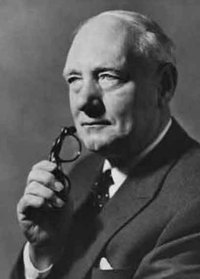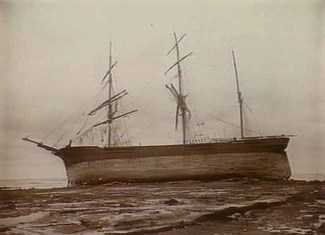 Sir Arthur Warner
Sir Arthur Warner THE Wreck Beach near Harmers Haven was a haven for the Bunorong people. In the sandhills at the edge of the beach around that part of the coast, many large shell middens give evidence of long occupation by the earliest people. The rock shelves thereabouts provided rich foraging grounds for high quality food resources. The shells of abalone, mussel, limpet and all sorts of sea snail make up the bulk of the midden content.
The rock shelf there also provided the impetus for the first European activity in the region. William Hovell (Hume’s mate) discovered the Rock and Queen coal seams there in 1826. They were later exploited to provide Victoria’s first coal and Hovell’s discovery led to the later discovery of the larger Powlett River coalfields which resulted in the establishment of Wonthaggi in 1909.
The rocky coast may have provided sustenance to the first people and the prospect of wealth to coal mine owners but was not entirely benign. During a wild storm in 1901, the three-masted, 100-year-old barque Artisan was driven ashore and wrecked on the rock shelf. Wreck Beach takes its name from this incident. There was no loss of life, but the ship was a write-off and was salvaged. Its rusty iron ribs can still be seen at The Wreck.
 The Artisan, wedged on the Harmers Haven rock shelf, 1901
The Artisan, wedged on the Harmers Haven rock shelf, 1901 In 1923, there was a wreck of a different kind at the same beach. A 20-metre sperm whale, possibly the biggest recorded in Victoria, washed onto the beach during yet another storm. Though it was probably illegal, locals made good use of the beast. Someone rendered the body for oil. The huge jaw bones still form a welcoming archway at Taberner’s Wonthaggi Hotel. Other bones disappeared: Webby, my next-door neighbour, obtained a couple of vertebrae and kept them in his fern house as flower pots with small ferns planted in the spinal chord space. The vertebrae were about 400 millimetres wide at their smallest diameter: very large.
The Wonthaggi coalmines were winding down in the 1950s. Number 20 Shaft, sunk in 1934, and infamous for a coal-gas explosion that killed 13 miners four years later, was almost exhausted. West Area, sunk in the late 1930s had small reserves, but the coal seams were thin and unproductive. Kirrak, operating since the 1940s, was also getting deeper, hotter and more difficult to operate. Miram’s Tunnel was into a small deposit, which was almost finished. There was an untouched deposit where a new mine could be sunk between West Area and Twenty Shaft. A decision had to be made about Wonthaggi’s future.
Sir Arthur Warner was Victorian Minister of Transport and therefore had responsibility for Victorian Railways, and hence, the State Coal Mine. Warner was a political “king maker” who was largely responsible for Sir Henry Bolte’s ascendancy to Liberal Leader and hence State Premier (for almost 20 years). Warner was also allegedly corrupt and allegations of conflict of interest followed his career.
Away from politics, Warner was an old sea dog. He owned a yawl, The Winston Churchill, in which he twice completed the Sydney to Hobart yacht race. Yachting occupied much of his free time.
In 1958, Warner marshalled party support and finalised a decision about Wonthaggi that was regarded as being set in stone: the mine would close 10 years hence and there would be no money for further developments.
Retrospectively, this seems to be a very fair and reasonable decision. There was to be no surprise and plenty of time for people to plan alternative futures. The mine would implode slowly as the remaining workforce aged and pits closed one by one. The operations had been unprofitable since the 1940s and demand for coal was falling (steam trains were being phased out) so closure was perfectly sensible.
Local community reaction to the decision was neither reasonable nor logical, however. There were protest meetings, strikes, marches on Parliament and petitions. Warner was burnt in effigy and his name was poison in the district. The pessimists believed mine closure would result in Wonthaggi becoming a ghost town and then disappearing altogether.
Dad got caught up in the madness and started mumbling about moving to the new Melbourne suburb of Noble Park. He went as far as inviting a local real estate agent home to give a valuation. That was a mistake: Dad should have consulted first. In a fury, Mum chased a fearful Doug Veale off our property and then gave Dad a belting.
The hatred for Warner simmered, and Sir Arthur was more than aware what was thought of him in that part of the world.
In April the following year, the jolly sailor was back at sea in his beloved Winston Churchill. April, when the muttonbird gales rage through Bass Strait, is not necessarily the optimum time to be in a yacht. And so it proved for Sir Arthur. He sailed into a severe storm and lost all control: the yacht was blown hither and yon. It was night, there was zero visibility and, of course, no GPS in those days; they had no idea where they were.
The boat actually made it almost as far east as Wilson’s Promontory, but a wall of wind then blew it backwards. Eventually the boat was thrown up onto the rock shelf at The Wreck. The master and crew still did not know that: they were totally lost.
Admiral Sir Arthur ordered “Abandon ship!” and the crew escaped toward the beach in their lifeboat. The surf was very heavy – Warner was thrown out of the boat and nearly lost and drowned – but they all made it safely to shore in the end.
At daylight, Warner and crew went in search of help. According to eyewitnesses, when they reached a farmhouse and were told that they were just outside Wonthaggi, Warner went as white as a ghost and almost fainted. Rather than continue to Wonthaggi, he went back to the beach to await a rescue party. He was afraid of being lynched if he showed his face in Wonthaggi. He was smuggled back to Melbourne, his presence only becoming known in Wonthaggi after he’d gone.
It took much more effort to rescue the Winston Churchill. After about two weeks, contractors managed to haul the boat off the rock shelf, over the beach, over the sandhills and up over the cliff where it was loaded onto a large truck. Before going off to Melbourne, the truck with the boat drove into Wonthaggi and parked outside Taberner’s Hotel.
It stayed there all day and that is where I went to see the boat. I think the whole town came to see it and it became the focus of every Warner hater in the district. It was also interesting that boat and whale had ended on the same beach and now were united at Taberner’s.
Warner’s plans for Wonthaggi were fulfilled and the mines closed in 1968, but the town did not cease to exist. Warner himself retired from parliament in 1964 and died in 1966, so he did not live to see the results.